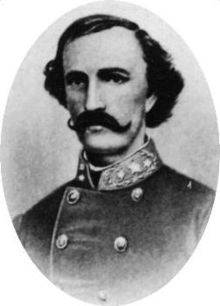Thomas James Churchill
Thomas James Churchill | |
|---|---|
 Churchill during the American Civil War | |
| 13th Governor of Arkansas | |
| In office January 11, 1881 – January 13, 1883 | |
| Preceded by | William Miller |
| Succeeded by | James Berry |
| Personal details | |
| Born | March 10, 1824 Louisville, Kentucky |
| Died | May 14, 1905 (aged 81) Little Rock, Arkansas |
| Resting place | Mount Holly Cemetery Little Rock, Arkansas 34°44′16.5″N 92°16′38.6″W / 34.737917°N 92.277389°W |
| Political party | Democratic |
| Military service | |
| Allegiance | |
| Branch/service | United States Volunteers Provisional Army of the Confederate States |
| Years of service | 1846–1847 (USV) 1861–1865 (PACS) |
| Rank | File:Confederate States of America General.png Major General (PACS) |
| Unit | 1st Kentucky Cavalry (1846–1847) |
| Commands | 1st Arkansas Mounted Rifles Churchill's Brigade Churchill's Division |
| Battles/wars | Mexican-American War American Civil War |
Thomas James Churchill (March 10, 1824 – May 14, 1905) was a Confederate major general during the American Civil War and the 13th Governor of Arkansas.
Biography
Churchill was born near Louisville, Kentucky. He graduated from St. Mary's College in Bardstown, Kentucky in 1844. He studied law at Transylvania University in Lexington.[1]
Churchill served during the Mexican-American War and rose to the rank of first lieutenant in the 1st Kentucky Mounted Rifles. He was captured by the Mexican Army and remained a prisoner of war until near the end of the conflict. In 1848, he moved to Little Rock, Arkansas, married the daughter of Senator Ambrose Sevier, and became a planter. Appointed by President James Buchanan, he was postmaster of Little Rock from 1857 to 1861.
Civil War
At the start of the Civil War, Churchill offered his services to the state and was elected colonel of the 1st Arkansas Mounted Rifles. His first combat took place at the Battle of Wilson's Creek near Springfield, Missouri. On March 4, 1862, he was promoted to Brigadier General and soon thereafter took part in Maj. Gen. Kirby Smith's Kentucky Campaign. Churchill played an important role in the victory at Richmond, Kentucky, commanding a division of men from Texas and Arkansas. Leading his division along a ravine that became known as "Churchill's Draw" he delivered a successful and surprising flanking attack. On February 17, 1864, Churchill was cited as one of three officers to receive special recognition in a Thanks of Confederate Congress resolution for his actions at Richmond.[2]
In the latter part of 1862, Churchill was transferred back to Arkansas and placed in charge of the fortifications at Arkansas Post. In January 1863, the Post was attacked and seized in the Battle of Fort Hindman by an overwhelming Union force under Maj. Gen. John A. McClernand. After his exchange Churchill continued his service in the Trans-Mississippi Department and commanded a division during the Red River Campaign. He played a major role in the Battle of Jenkins Ferry and was promoted to Major General on March 17, 1865.[2]
Postbellum
In the Brooks-Baxter War in 1874, Churchill supported Baxter and helped enroll volunteers in Baxter's militia. Churchill was elected Arkansas State Treasurer in 1874, and was reelected in 1876 and 1878.
Churchill was elected Governor of Arkansas in 1881, and served until his resignation in 1883.[3]
While governor, Churchill was plagued by allegations of discrepancies in the treasurer's account from when he served as state treasurer. A special committee found a shortage in the state funds, and a lawsuit was brought against Churchill. Churchill was ordered to repay the missing funds.[4]
Death and legacy
Churchill died in Little Rock, Arkansas, and was buried in historic Mount Holly Cemetery with military honors.
Churchill set the standard for the pronunciation of "Arkansas."[1]
See also
- Brooks–Baxter War
- List of American Civil War Generals (Confederate)
- List of Governors of Arkansas
- The Family (Arkansas politics)
Notes
- ^ a b "Thomas James Churchill (1881-1883)". Old State House Museum. Retrieved August 14, 2012.
- ^ a b Eicher, p. 173.
- ^ "Arkansas Governor Thomas James Churchill". National Governors Association. Retrieved August 14, 2012.
- ^ "Thomas James Churchill (1824–1905)". The Encyclopedia of Arkansas History & Culture. Retrieved August 14, 2012.
References
- Eicher, John H., and David J. Eicher, Civil War High Commands. Stanford: Stanford University Press, 2001. ISBN 978-0-8047-3641-1.
- Sifakis, Stewart. Who Was Who in the Civil War. New York: Facts On File, 1988. ISBN 978-0-8160-1055-4.
- Warner, Ezra J. Generals in Gray: Lives of the Confederate Commanders. Baton Rouge: Louisiana State University Press, 1959. ISBN 978-0-8071-0823-9.
External links
- Thomas James Churchill at Find a Grave
- The Encyclopedia of Arkansas History & Culture
- Montgomery, Don, "Thomas James Churchill", Encyclopedia of Arkansas History & Culture, accessed June 8, 2010.
- National Governors Association
- Old State House Museum
- 1824 births
- 1905 deaths
- American prisoners of war
- Arkansas Democrats
- Burials at Mount Holly Cemetery, Little Rock
- Confederate States Army major generals
- Democratic Party state governors of the United States
- Governors of Arkansas
- Mexican–American War prisoners of war held by Mexico
- People of Arkansas in the American Civil War
- Politicians from Louisville, Kentucky
- Transylvania University alumni

